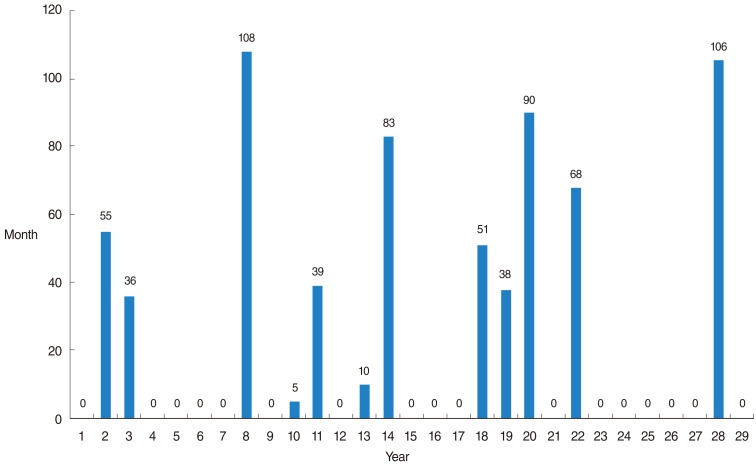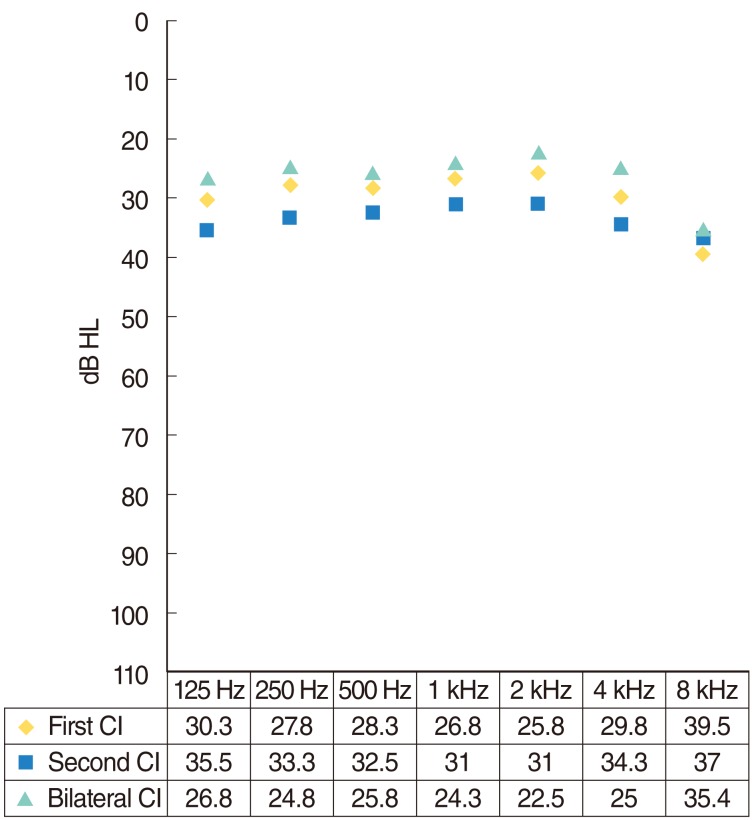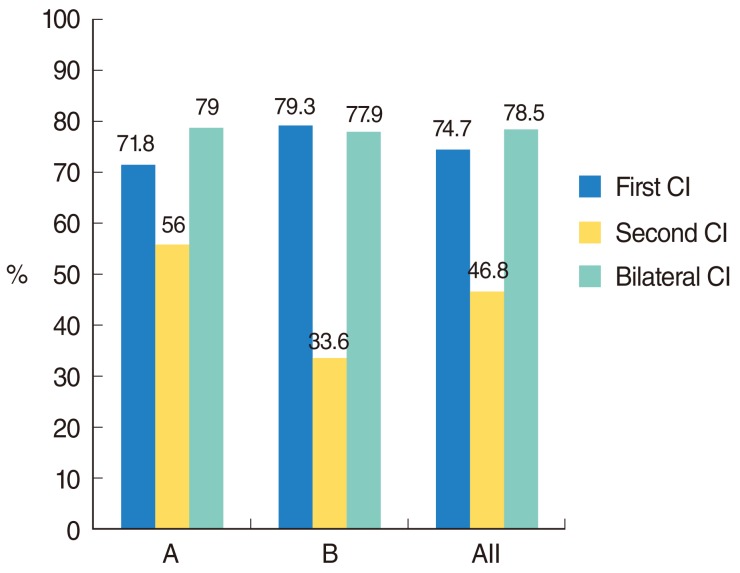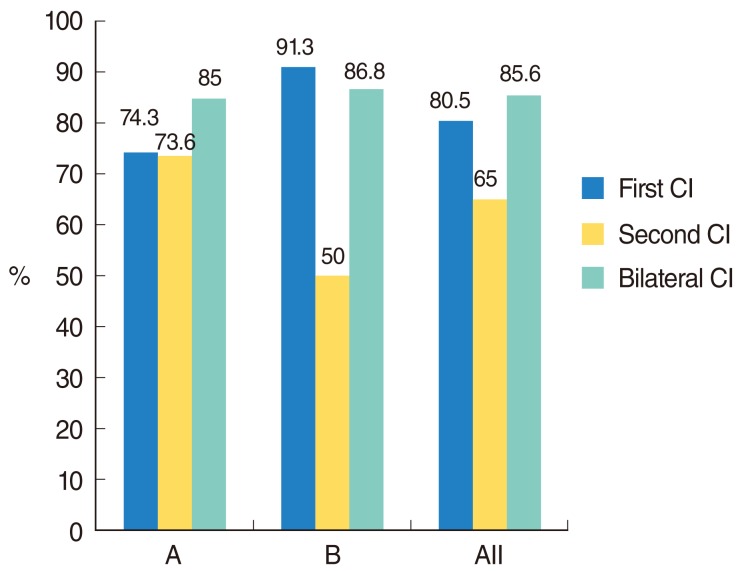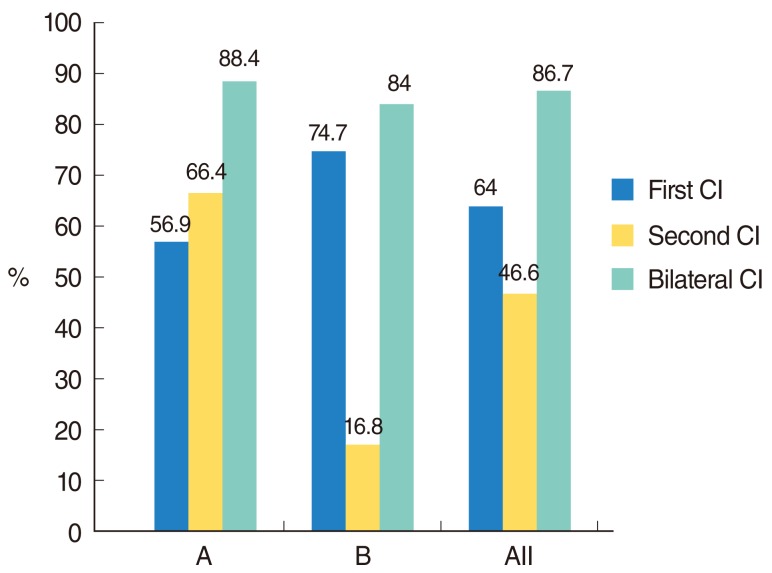Clin Exp Otorhinolaryngol.
2012 Apr;5(Suppl 1):S24-S31.
Bilateral Cochlear Implantation for Children in Nagasaki, Japan
- Affiliations
-
- 1Kanda ENT Clinic, Nagasaki Bell Hearing Center, Nagasaki, Japan. n-bell@estate.ocn.ne.jp
- 2Department of Otolaryngology Head and Neck Surgery, Nagasaki University Graduate School of Biomedical Sciences, Nagasaki, Japan.
Abstract
OBJECTIVES
The number of patients with bilateral cochlear implant (CI) has gradually increased as patients and/or parents recognize its effectiveness. The purpose of this report is to evaluate the efficacy of 29 bilateral CI out of 169 pediatric CI users, who received auditory-verbal/oral habilitation at our hearing center.
METHODS
We evaluated the audiological abilities 29 Japanese children with bilateral CIs including wearing threshold, word recognition score, speech discrimination score at 1 m from front speaker (SP), 1 m from second CI side SP, speech discrimination score under the noise (S/N ratio=80 dB sound pressure level [SPL]/70 dB SPL, 10 dB) at 1 m from front SP, word recognition score under the noise (S/N ratio=80 dB SPL/70 dB SPL, 10 dB) at 1 m from front SP.
RESULTS
Binaural hearing using bilateral CI is better than first CI in all speech understanding tests. Especially, there were significant differences between the results of first CI and bilateral CI on SDS at 70 dB SPL (P=0.02), SDS at 1 m from second CI side SP at 60 dB SPL (P=0.02), word recognition score (WRS) at 1 m from second CI side SP at 60 dB SPL (P=0.02), speech discrimination score (SDS) at 1 m from front SP under the noise (S/N=80/70; P=0.01) and WRS at 1 m from front SP under the noise (S/N=80/70; P=0.002). At every age, a second CI is very effective. However, the results of under 9 years old were better than of over 9 years old on the mean SDS under the noise (S/N=80/70) on second CI (P=0.04). About use of a hearing aid (HA) in their opposite side of first CI, on the WRS and SDS under the noise, there were significant differences between the group of over 3 years and the group of under 10 months of HA non user before second CI.
CONCLUSION
These results may show important binaural effectiveness such as binaural summation and head shadow effect. Bilateral CI is very useful medical intervention for many children with severe-to-profound hearing loss in Japan as well as elsewhere.
Keyword
MeSH Terms
Figure
Reference
-
1. Balkany T, Boggess W, Dinner B. Binaural cochlear implantation: comparison of 3M/House and Nucleus 22 devices with evidence of sensory integration. Laryngoscope. 1988; 10. 98(10):1040–1043. PMID: 3172948.2. Muller J, Schon F, Helms J. Speech understanding in quiet and noise in bilateral users of the MED-EL COMBI 40/40+ cochlear implant system. Ear Hear. 2002; 6. 23(3):198–206. PMID: 12072612.3. Kuhn-Inacker H, Shehata-Dieler W, Müller J, Helms J. Bilateral cochlear implants: a way to optimize auditory perception abilities in deaf children? Int J Pediatr Otorhinolaryngol. 2004; 10. 68(10):1257–1266. PMID: 15364496.4. Schon F, Muller J, Helms J. Speech reception thresholds obtained in a symmetrical four-loudspeaker arrangement from bilateral users of MED-EL cochlear implants. Otol Neurotol. 2002; 9. 23(5):710–714. PMID: 12218624.5. Tyler RS, Dunn CC, Witt SA, Preece JP. Update on bilateral cochlear implantation. Curr Opin Otolaryngol Head Neck Surg. 2003; 10. 11(5):388–393. PMID: 14502072.
Article6. Vermeire K, Brokx JP, Van de Heyning PH, Cochet E, Carpentier H. Bilateral cochlear implantation in children. Int J Pediatr Otorhinolaryngol. 2003; 1. 67(1):67–70. PMID: 12560152.
Article7. Au DK, MapplSc A, Hui Y, Wei WI. Superiority of bilateral cochlear implantation over unilateral cochlear implantation in tone discrimination in chinese patients. Am J Otolaryngol. 2003; Jan-Feb. 24(1):19–23. PMID: 12579478.
Article8. Richard JM, Hoesel V, Tyler RS. Speech perception, localization, and lateralization with bilateral cochlear implants. J Acoust Soc Am. 2003; 3. 113(3):1617–1630. PMID: 12656396.9. Litovsky RY, Johnstone PM, Godar S, Agrawal S, Parkinson A, Peters R, et al. Bilateral cochlear implants in children: localization acuity measured with minimum audible angle. Ear Hear. 2006; 2. 27(1):43–59. PMID: 16446564.
Article10. Sharma A, Dorman MF, Kral A. The influence of a sensitive period on central auditory development in children with unilateral and bilateral cochlear implants. Hear Res. 2005; 5. 203(1-2):134–143. PMID: 15855038.
Article11. Steffens T, Lesinski-Schiedat A, Strutz J, Aschendorff A, Klenzner T, Rühl S, et al. The benefits of sequential bilateral cochlear implantation for hearing-impaired children. Acta Otolaryngol. 2008; 2. 128(2):164–176. PMID: 17851947.
Article12. Brown KD, Balkany TJ. Benefits of bilateral cochlear implantation: a review. Curr Opin Otolaryngol Head Neck Surg. 2007; 10. 15(5):315–318. PMID: 17823546.
Article13. Murphy J, O'Donoghue G. Bilateral cochlear implantation: an evidence-based medicine evaluation. Laryngoscope. 2007; 8. 117(8):1412–1418. PMID: 17607146.
Article14. Papsin BC, Gordon KA. Bilateral cochlear implants should be the standard for children with bilateral sensorineural deafness. Curr Opin Otolaryngol Head Neck Surg. 2008; 2. 16(1):69–74. PMID: 18197026.
Article15. Bond M, Mealing S, Anderson R, Elston J, Weiner G, Taylor RS, et al. The effectiveness and cost-effectiveness of cochlear implants for severe to profound deafness in children and adults: a systematic review and economic model. Health Technol Assess. 2009; 9. 13(44):1–330.
Article
- Full Text Links
- Actions
-
Cited
- CITED
-
- Close
- Share
- Similar articles
-
- Bilateral Cochlear Implantation in Four Children
- Cochlear Implantation in a Deaf Patient with Bilateral Temporal Bone Fractures
- The Usefulness of Reconstructed 3D Images in Surgical Planning for Cochlear Implantation in a Malformed Ear with an Abnormal Course of the Facial Nerve
- A Case of Cochlear Implantation after Bilateral Temporal Bone Fracture
- Auditory Rehabilitation - Cochlear Implantation



